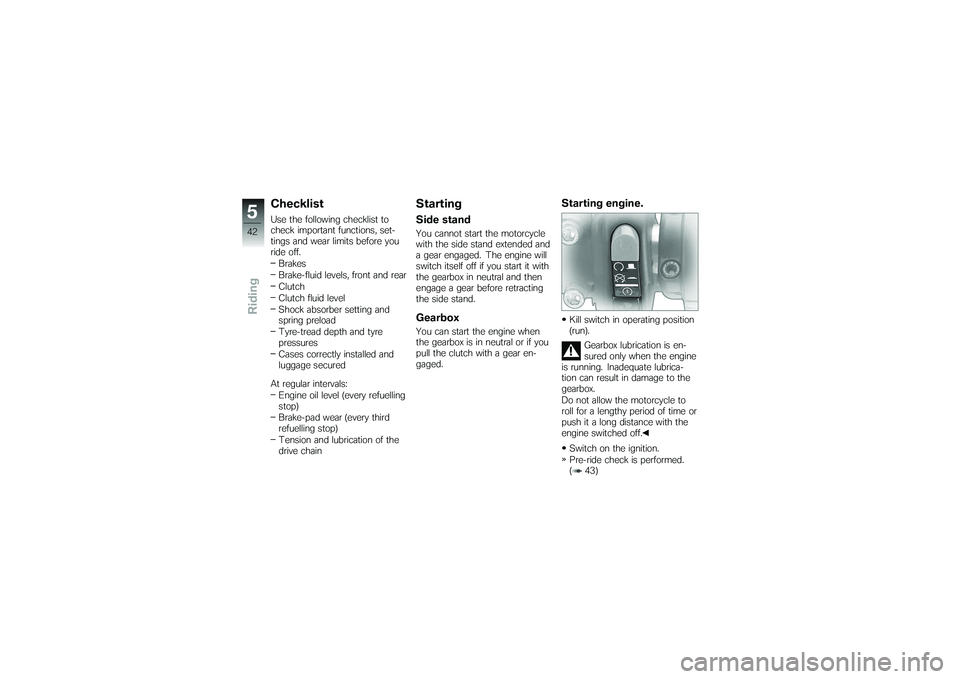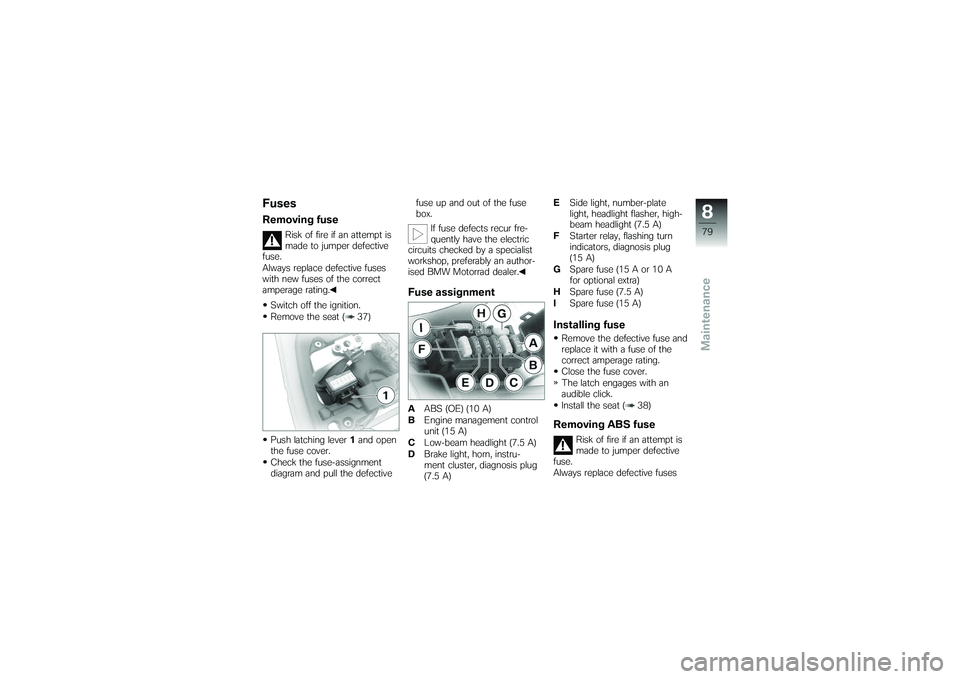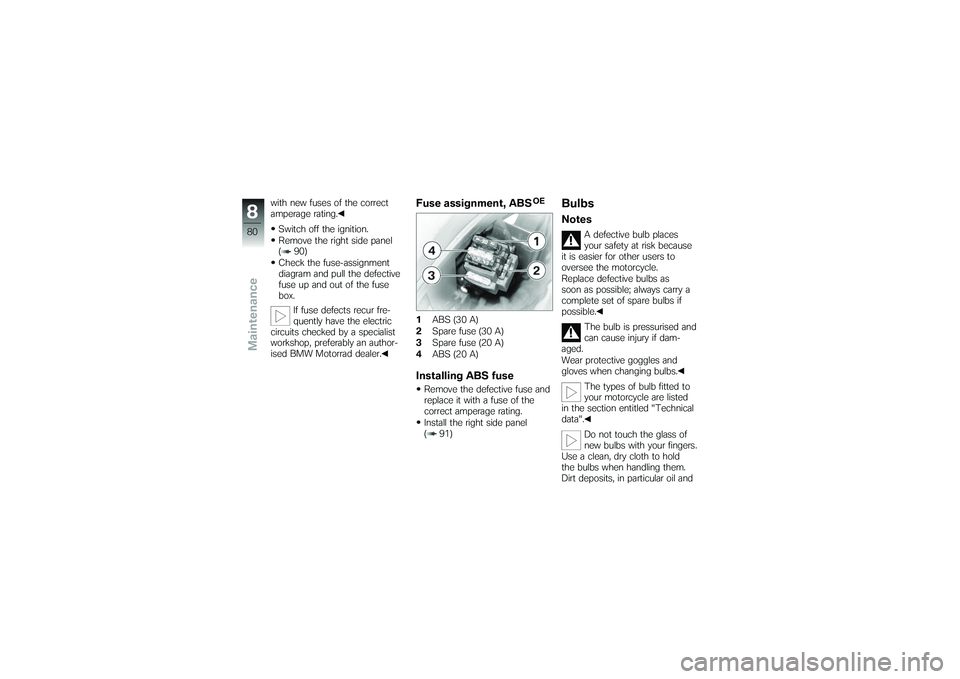Page 40 of 126
Pull the seat to the rear to re-
move.
Place the seat, upholstered
side down, on a clean surface.Installing seatPosition seat2in such a way
that mounts 3on left and right
are in front of left and right
holders 4. If too much pressure is ap-
plied in the forward direc-
tion, there is a danger that the
motorcycle will be pushed off its
stand.
Always make sure that the
motorcycle is stable and firmly
supported.
Lower seat 2into position and
push it forward as far as it will
go.
Firmly press down on the seat
at the rear.
The seat engages with an aud-
ible click.
Check that the seat is secure.
438zOperation
Page 44 of 126

ChecklistUse the following checklist to
check important functions, set-
tings and wear limits before you
ride off.Brakes
Brake-fluid levels, front and rear
Clutch
Clutch fluid level
Shock absorber setting and
spring preload
Tyre-tread depth and tyre
pressures
Cases correctly installed and
luggage secured
At regular intervals: Engine oil level (every refuelling
stop)
Brake-pad wear (every third
refuelling stop)
Tension and lubrication of the
drive chain
StartingSide standYou cannot start the motorcycle
with the side stand extended and
a gear engaged. The engine will
switch itself off if you start it with
the gearbox in neutral and then
engage a gear before retracting
the side stand.GearboxYou can start the engine when
the gearbox is in neutral or if you
pull the clutch with a gear en-
gaged.
Starting engine.Kill switch in operating position
(run).
Gearbox lubrication is en-
sured only when the engine
is running. Inadequate lubrica-
tion can result in damage to the
gearbox.
Do not allow the motorcycle to
roll for a lengthy period of time or
push it a long distance with the
engine switched off.
Switch on the ignition.
Pre-ride check is performed.
( 43)
542zRiding
Page 74 of 126
Installing front wheelInstall spacer sleeve7.
The front wheel must be
installed right way round to
rotate in the correct direction.
Note the direction-of-rotation ar-
rows on the tyre or the wheel
rim.
Roll the front wheel into posi-
tion between the forks, making
sure that the brake disc passes
between the brake pads. Install axle
5.
Threaded fasteners not
tightened to the specified
torque can work loose or their
threads can suffer damage.
Always have the security of the
fasteners checked by a specialist workshop, preferably an author-
ised BMW Motorrad dealer.
Tighten axle screw 3to the
specified torque; if necessary
use a screwdriver to counter-
hold at the right-hand side.
Nut on quick-release
axle, front
80 Nm
Remove the front-wheel stand.
Without operating the brakes:
firmly compress the forks and
release; repeat the procedure
several times.
Tighten left axle clamping
screws 2to the specified
tightening torque.
Front-axle retainer
10 Nm
872zMaintenance
Page 80 of 126
Slacken adjusting screws1of
the front-wheel stand.
Push the two adapters 2apart
until the front forks fit between
them.
Use locating pins 3to set the
front-wheel stand to the de-
sired height.
Centre the front-wheel stand
relative to the front wheel and
push it against the front axle. Align the two adapters
2so
that the front forks are securely
seated.
Tighten adjusting screws 1. If the front of the motor-
cycle is raised too far the
auxiliary stand will lift clear of the
ground and the motorcycle could
topple to one side.
When raising the motorcycle,
make sure that the auxiliary stand
remains on the ground. If ne-
cessary, adjust the height of the
front-wheel stand or the auxiliary
stand.
Apply uniform pressure to push
the front-wheel stand down
and raise the motorcycle.
878zMaintenance
Page 81 of 126

FusesRemoving fuse
Risk of fire if an attempt is
made to jumper defective
fuse.
Always replace defective fuses
with new fuses of the correct
amperage rating.
Switch off the ignition.
Remove the seat ( 37)
Push latching lever 1and open
the fuse cover.
Check the fuse-assignment
diagram and pull the defective fuse up and out of the fuse
box.
If fuse defects recur fre-
quently have the electric
circuits checked by a specialist
workshop, preferably an author-
ised BMW Motorrad dealer.
Fuse assignmentA ABS (OE) (10 A)
B Engine management control
unit (15 A)
C Low-beam headlight (7.5 A)
D Brake light, horn, instru-
ment cluster, diagnosis plug
(7.5 A) E
Side light, number-plate
light, headlight flasher, high-
beam headlight (7.5 A)
F Starter relay, flashing turn
indicators, diagnosis plug
(15 A)
G Spare fuse (15 A or 10 A
for optional extra)
H Spare fuse (7.5 A)
I Spare fuse (15 A)
Installing fuseRemove the defective fuse and
replace it with a fuse of the
correct amperage rating.
Close the fuse cover.
The latch engages with an
audible click.
Install the seat ( 38)Removing ABS fuse
Risk of fire if an attempt is
made to jumper defective
fuse.
Always replace defective fuses
879zMaintenance
Page 82 of 126

with new fuses of the correct
amperage rating.Switch off the ignition.
Remove the right side panel
( 90)
Check the fuse-assignment
diagram and pull the defective
fuse up and out of the fuse
box. If fuse defects recur fre-
quently have the electric
circuits checked by a specialist
workshop, preferably an author-
ised BMW Motorrad dealer.
Fuse assignment, ABS
OE
1 ABS (30 A)
2 Spare fuse (30 A)
3 Spare fuse (20 A)
4 ABS (20 A)Installing ABS fuseRemove the defective fuse and
replace it with a fuse of the
correct amperage rating.
Install the right side panel
( 91)
BulbsNotes
A defective bulb places
your safety at risk because
it is easier for other users to
oversee the motorcycle.
Replace defective bulbs as
soon as possible; always carry a
complete set of spare bulbs if
possible.
The bulb is pressurised and
can cause injury if dam-
aged.
Wear protective goggles and
gloves when changing bulbs.
The types of bulb fitted to
your motorcycle are listed
in the section entitled "Technical
data".
Do not touch the glass of
new bulbs with your fingers.
Use a clean, dry cloth to hold
the bulbs when handling them.
Dirt deposits, in particular oil and
880zMaintenance